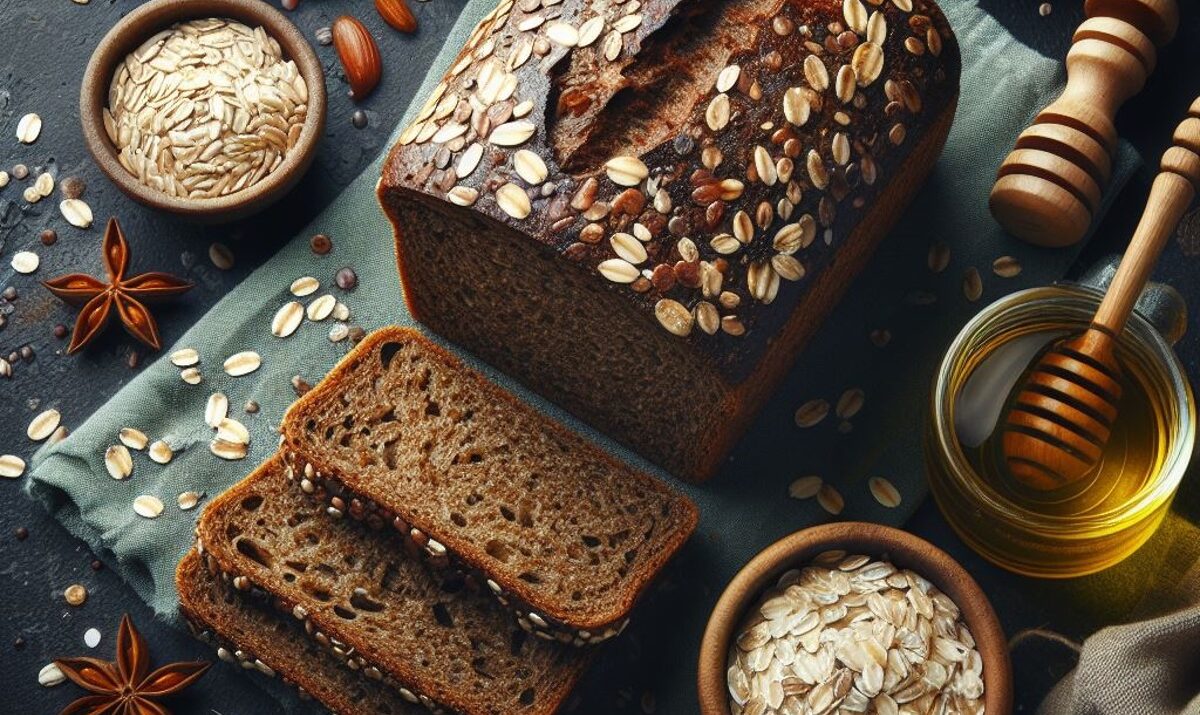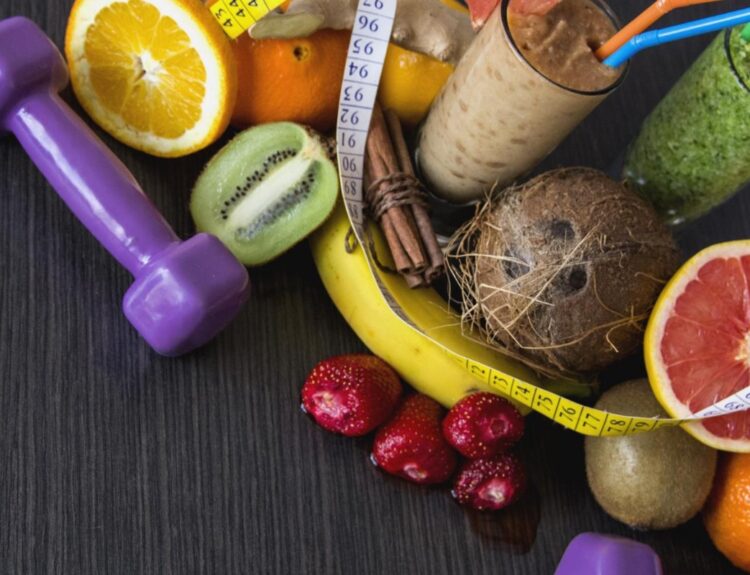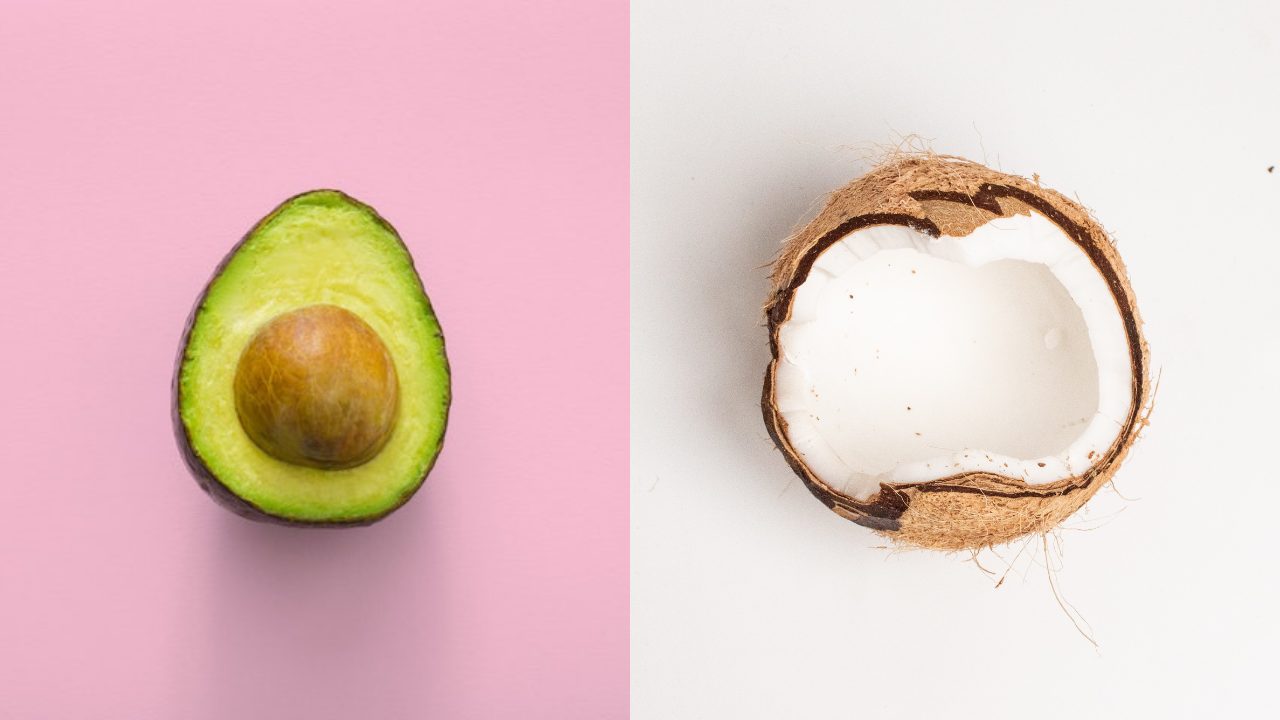Is fitness bread good for you? This question has sparked curiosity among health-conscious individuals looking for nourishing alternatives in their diet. As the health and wellness industry emphasizes the importance of making mindful food choices, this bread has steadily gained attention for its purported benefits. This article uncovers fitness bread’s nutritional profile, health benefits, and how it stacks up against other varieties.
Is fitness bread good for you? Learn about its nutritional benefits and how to make homemade fitness bread.
In this article:
- What is Fitness Bread?
- Is Fitness Bread Good for You: Nutritional Profile
- Is Fitness Bread Good for You: Health Benefits
- Is Fitness Bread Good for You: Comparisons with Other Types of Bread
- Incorporating Fitness Bread into Your Diet
- Homemade Fitness Bread Recipes
What is Fitness Bread?
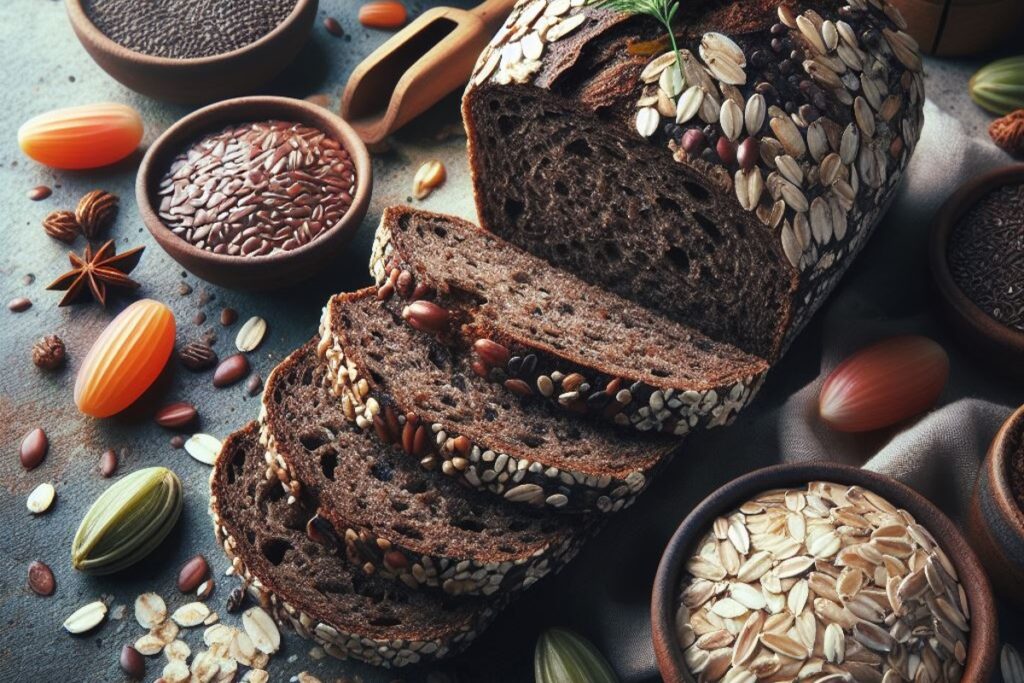
Fitness bread, a rising star in health-conscious diets, is a versatile and nutrient-packed alternative to traditional bread. But what sets it apart? At its core, this bread is specially crafted to cater to the nutritional needs of those seeking a healthier lifestyle.
This bread often boasts a robust combination of whole grains, seeds, and other wholesome ingredients, making it a powerhouse of essential nutrients. The primary aim is to provide a bread option that satisfies cravings and contributes positively to overall well-being.
Typically, this bread includes a mix of grains like oats, barley, and rye paired with nutrient-rich seeds such as flaxseeds, sunflower seeds, and chia seeds. The result is a dense, hearty loaf with satisfying crunch and nutritional benefits.
Rich in dietary fiber, this bread supports digestion and provides a satisfying feeling of fullness. Additionally, it often boasts a lower glycemic index than traditional white bread, making it a favorable choice for those mindful of blood sugar levels.
So, is fitness bread good for you? Let’s explore its nutritional profile.
IS FITNESS BREAD GOOD FOR YOU: NUTRITIONAL PROFILE
First and foremost, fitness bread is rich in complex carbohydrates, primarily derived from whole grains like oats, barley, and rye. These carbohydrates provide sustained energy release, keeping you fueled throughout the day without causing rapid spikes in blood sugar levels.
Furthermore, this bread is a notable source of dietary fiber, essential for digestive health and promoting a feeling of fullness. The blend of grains and seeds contributes to its fiber content, aiding digestion and supporting a healthy gut microbiome.
Regarding protein content, fitness bread often contains a decent amount, including flaxseeds, sunflower, and chia seeds. Protein helps muscle repair and growth, making this bread a beneficial addition to a balanced diet, especially for individuals with an active lifestyle.
Additionally, this bread is typically low in saturated fats and often free from added sugars and artificial additives, which makes it a heart-healthy option.
The nutritional profile of this bread showcases a harmonious blend of complex carbohydrates, dietary fiber, protein, and essential micronutrients.
By incorporating fitness bread into your diet, you can enjoy a delicious option that promotes optimal health and wellness.
IS FITNESS BREAD GOOD FOR YOU: HEALTH BENEFITS
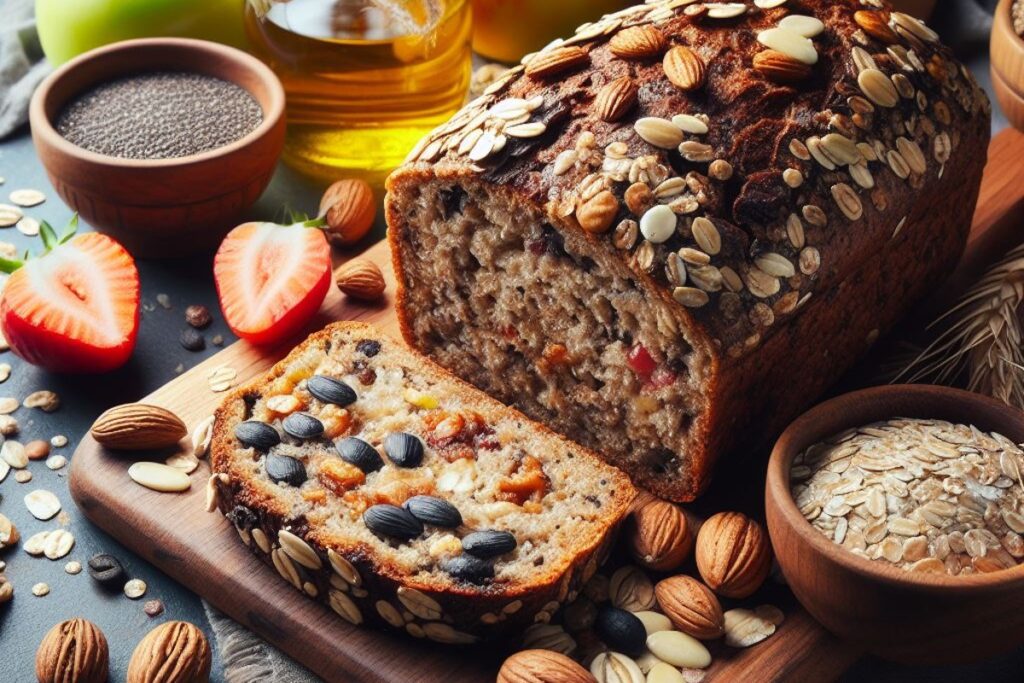
Is fitness bread good for you and your health? Let’s explore the advantages of adding this bread to your dietary routine.
- Weight Management: Fitness bread’s rich fiber content is pivotal in promoting satiety, aiding in weight management efforts. Fostering a feeling of fullness helps reduce excessive calorie intake, supporting a balanced and healthy weight.
- Digestive Health: The abundant dietary fiber in this bread supports digestive health and alleviates digestive issues like constipation.
- Blood Sugar Control: With its low glycemic index, this bread facilitates better blood sugar regulation, making it suitable for people with diabetes or those aiming to stabilize their blood sugar levels. It promotes gradual glucose release, preventing sudden spikes and crashes, thereby supporting metabolic health.
- Heart Health: The absence of saturated fats and added sugars in fitness bread aligns with heart-healthy dietary recommendations. Regular consumption may contribute to maintaining healthy cholesterol levels and decreasing the risk of cardiovascular issues, making it a heart-smart choice.
So, why not incorporate this wholesome option into your diet today and experience its potential benefits firsthand?
IS FITNESS BREAD GOOD FOR YOU: COMPARISONS WITH OTHER TYPES OF BREAD
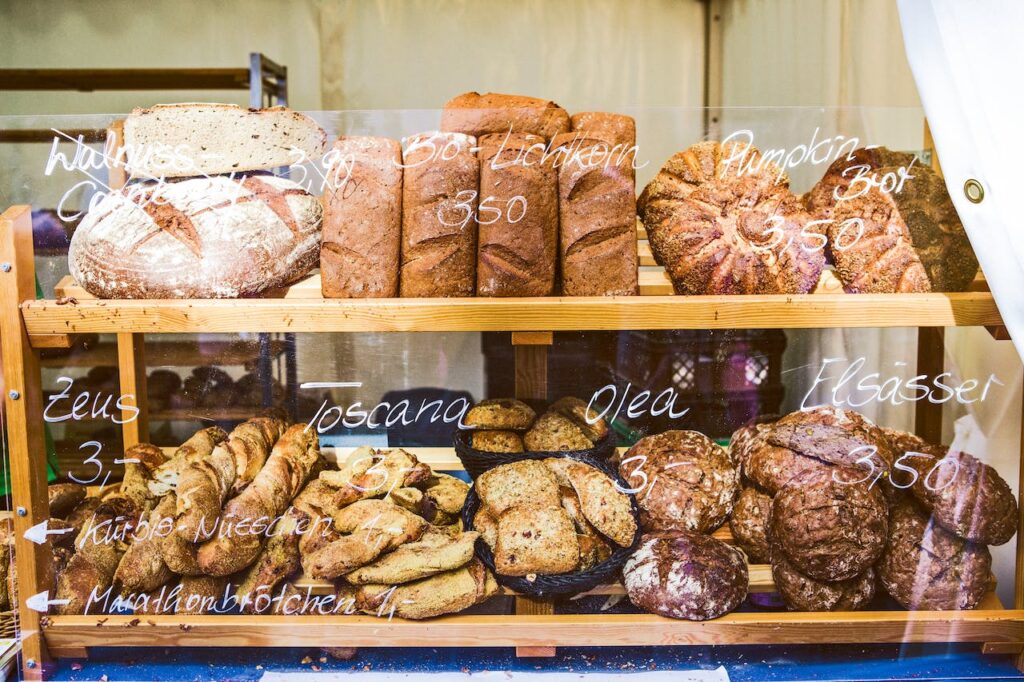
Fitness bread is a superior choice to traditional white bread, which often lacks essential nutrients due to refining processes. Its low glycemic index and absence of added sugars make it particularly advantageous for individuals aiming to stabilize blood sugar and manage weight effectively.
While whole grain bread is a solid nutritional choice, fitness bread amplifies these benefits, providing a more concentrated source of vital nutrients and fiber, ultimately promoting a more satisfying and healthful eating experience. These bread types share the foundational advantages of whole grains, including fiber content and essential nutrients. However, fitness bread elevates these nutritional attributes by incorporating a diverse blend of grains and seeds. This unique blend enhances the fiber content beyond what is typically found in traditional whole-grain bread and enriches the overall nutrient density.
For those with gluten intolerance or diagnosed celiac disease considering gluten-free options, this bread crafted from gluten-free grains and seeds stands out as a nutritious alternative. It addresses dietary restrictions without compromising taste or nutritional value, offering a balanced blend of fiber, protein, and essential nutrients.
Furthermore, although sourdough bread boasts unique fermentation properties that may confer digestive benefits, fitness bread’s comprehensive nutrient profile, enriched with fiber-rich grains and seeds, positions it favorably for promoting digestive health and overall vitality.
INCORPORATING FITNESS BREAD INTO YOUR DIET
Here’s a guide to incorporating this nutritious option into your diet:
- Breakfast: Start your day on a nutritional note by incorporating this bread into your breakfast routine. Toast a slice with avocado or poached eggs for a satisfying and protein-packed meal. Alternatively, use it as a base for a wholesome breakfast sandwich layered with lean proteins and fresh veggies.
- Lunchtime: Upgrade your lunchtime meals by choosing this bread as a sandwich base or side option. Create nutrient-rich sandwiches with lean meats, fresh greens, and flavorful condiments. Pair it with a soup or salad to create a balanced and satisfying midday meal.
- Snack: Combat afternoon cravings by enjoying this bread as a nutritious snack. Top it with hummus, cheese, or sliced fruits for a quick and energizing snack that keeps you fueled throughout the day. Its dense and hearty texture makes it a perfect canvas for nutritious toppings and spreads.
- Dinner: Consider using tuna as a topping for a fitness bread-based open-faced sandwich. Add some melted cheese, sliced tomatoes, and fresh herbs for a flavorful dinner.
- Dessert: Create a delicious dessert option by toasting bread and topping it with sliced bananas, a drizzle of chocolate or caramel sauce, and a sprinkle of nuts for added crunch.
Experiment with different recipes to discover how this wholesome option can enhance your culinary experiences.
HOMEMADE FITNESS BREAD RECIPES
You can always buy fitness bread, but the beauty of homemade bread lies in its delicious taste and nutritional prowess. By choosing quality ingredients and embracing a mindful baking approach, you can create bread that satisfies your taste buds and fuels your body with essential nutrients.
In the video above, you can see a step-by-step guide to making a wholesome Fitness Bread right in the comfort of your kitchen. But, it is not the only way to make fitness bread. There are many variants with different ingredients. Here are some suggestions:
Classic Whole-Grain Fitness Bread
Ingredients:
- 2 cups Whole Wheat Flour
- 1 cup Rolled Oats
- 1/2 cup Chia Seeds
- 3 tsp Baking Powder
- 1 tsp Sea Salt
- 1 1/2 cups Water
- 1/4 cup Olive Oil
Instructions:
- Preheat your oven to 180ºC.
- Mix dry ingredients in a large bowl.
- Add water and olive oil, then stir until well combined.
- Pour the mixture into a baking dish, smoothing the top.
- Bake for 45-50 minutes or until golden brown. Allow to cool before slicing.
Gluten-Free Fitness Bread with Seeds
Ingredients:
- 2 cups Gluten-Free Flour Mix
- 1 cup Sunflower Seeds
- 1/2 cup Pumpkin Seeds
- 4 tsp Baking Powder
- 1 tsp Himalayan Salt
- 1 1/2 cups Almond Milk
- 3 tbsp Maple Syrup
Instructions:
- Preheat oven to 180ºC.
- Combine all dry ingredients in a bowl.
- Add almond milk and maple syrup, mixing until a dough forms.
- Transfer to a greased loaf pan, smoothing the top.
- Bake for 55-60 minutes. Let cool before slicing.
Savory Herb Fitness Bread
Ingredients:
- 2 1/2 cups Spelt Flour
- 1/2 cup Ground Flax Seeds
- 2 tsp Baking Powder
- 1 tsp Himalayan Salt
- 1/2 cup Fresh Herbs (e.g., Rosemary, Thyme)
- 1 1/4 cups Water
- 1/4 cup Olive Oil
Instructions:
- Preheat oven to 180ºC.
- Mix spelt flour, ground flax seeds, baking powder, salt, and chopped herbs in a bowl.
- Add water and olive oil, stirring until combined.
- Pour into a loaf pan; smooth the top.
- Bake for about 50-55 minutes (until a toothpick comes out clean). Cool before slicing.
Feel free to adjust quantities or add your twist to these recipes to create a bread that suits your taste. Experimenting in the kitchen and changing recipes to satisfy your taste is part of the fun and creativity of baking!
_____
Is fitness bread good for you? The answer lies in its nutritional benefits and health advantages. Its unique profile offers benefits from weight management to heart health. Whether store-bought or homemade, integrating this bread into your diet aligns taste with well-being.
This post may contain affiliate links. You can read the affiliate disclosure here.

